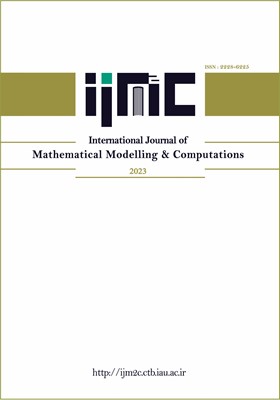An Application of Intelligent Algorithms in Solving Chemistry Problems
Subject Areas : International Journal of Mathematical Modelling & Computations
Hossein Jafari
1
*
![]() ,
Setareh Salehfard
2
,
Masoumeh Danesh Shakib
3
,
Setareh Salehfard
2
,
Masoumeh Danesh Shakib
3
1 - Young Researchers and Elite Club, Arak Branch, Islamic Azad University, Arak, Iran.
2 - Department of Computer Science, Arak Branch, Islamic Azad University, Arak, Iran.
3 - Department of industrial management, College of management and accounting, Qazvin branch, Islamic Azad university, Qazvin, Iran.
Keywords: Genetic Algorithm, Chemistry, Reaction Equilibrium, Mathematics and Computer,
Abstract :
Chemistry is undoubtedly the most practical science in our life, if we pay attention to the nature around us from the moment we wake up until the day ends, we will find that at the moment of the day and night, we are surrounded by different chemicals. And we have work. In fact, many of our daily activities are related to chemical processes. This has caused the expansion of chemistry and has caused the emergence of various problems. This study aims to analyze a classical chemistry problem known as the chemical reaction equilibrium, which has no uniform solution in different scenarios. In other words, different types of chemical reactions may require diverse methods for establishing equilibrium. This paper proposes a simple system for each chemical reaction through the law of conservation of mass (LCM) and basic mathematical concepts. Optimization algorithms (e.g., the genetic algorithm) are then employed to find a solution to this system.
[1] M. Ahmadipanah, K. Chalaki and R. Shakeri, Designing cell production arrangement scenarios with the
approach of artificial neural networks, Journal of System Management, 8 (4) (2022) 49–64.
[2] B. Ashrafijoo, N. Fegh-hi Farahmand, Y. Alavi Matin and K. Rahmani, Designing an optimal model using
artificial neural networks to predict non-linear time series (case study: Tehran stock exchange index), Journal
of System Management, 8 (4) (2022) 65–80.
[3] J. M. Campanario, Automatic ‘balancing’ of chemical equations, Computers & Chemistry, 19 (2) (1995) 85–
90.
[4] P. C. Chang, W. H. Huang and C. J. Ting, Dynamic diversity control in genetic algorithm for mining
unsearched solution space in TSP problems, Expert System with Application, 37 (2010) 1863–1878.
[5] R. Hendi, P. Robbs, B. Sampson, R. Pearce and N. Rees, The electrochemical reduction kinetics of oxygen in
dimethylsulfoxide, Journal of Electroanalytical Chemistry, 829 (15) (2018) 16–19.
[6] H. Jafari, M. Ehsanifar and A. Sheykhan, Finding optimum facility’s layout by developed simulated annealing
algorithm, International Journal of Research in Industrial Engineering, 9 (2) (2020) 172–182.
[7] H. Jafari, M. Faraji and R. Farsi, Evaluation of performance of different units of water and wastewater
company using DEA, International Journal of Applied Operational Research, 9 (3) (2019) 21–27.
[8] H. Jafari, M. Faraji and P. Khaleghi Ardehali, A heuristic method to calculate the real internal rate of return
(RIRR), International Journal of Applied Operational Research, 10 (1) (2020) 31–40.
[9] H. Jafari, M. Faraji and M. Ehsanifar, Solve the facility’s layout problem by developed genetic algorithm,
International Journal of Applied Operational Research, 8 (1) (2018) 23–32.
[10] H. Jafari and A. Sheykhan, Integrating developed evolutionary algorithm and Taguchi method for solving
fuzzy facility’s layout problem, Fuzzy Optimization and Modeling Journal, 2 (3) (2021) 24–35.
[11] J. Jlassi, I. Rekik, S. Elloumi and H. Chabchoub, Genetic algorithm for patients scheduling in emergency
department: A case study, International Journal of Supply and Operations Management, 10 (4) (2023) 439–
455.
[12] S. Katoch, S. S. Chauhan and V. Kumar, A review on genetic algorithm: past, present, and future, Multimedia
Tools and Applications, 80 (2021) 8091–8126.
[13] J. C. Kotz, P. M. Trichel and G. C. Weaver, Chemistry and Chemical Reactivity, Thomson Publication, 6th
edition, (2006) 11–13.
[14] S. Nayeri, R. Tavakkoli-Moghaddam, Z. Sazvar and J. heydari, Solving an emergency resource planning
problem with deprivation time by a hybrid metaheuristic algorithm, Journal of Quality Engineering and
Production Optimization, 5 (1) (2020) 65–86.
[15] J. C. Phillips, Algebraic constructs for the graphical and computational solution to balancing chemical
equations, Computers & Chemistry, 22 (4) (1998) 295–308.
[16] P. Ramasami, A concise description of an old problem: application of matrices to obtain the balancing
coefficients of chemical equations, Journal of mathematical chemistry, 34 (2) (2003) 21–26.
[17] I. B. Risteski, A new algebra for balancing special chemical reactions. Chemistry, 21 (2012) 223–234.
[18] L. M. Schmitt, C. N. Nehaniv and R. H. Fujii, Linear analysis of genetic algorithms, Theoretical Computer
Science, 208 (1998) 111–148.
[19] A. Slowik and H. Kwasnicka, Evolutionary algorithms and their applications to engineering problems, Neural
Computing and Applications, 32 (2020) 12363–12379.
[20] Z. Tóth, Balancing chemical equations by inspection, Journal of Chemical Education, 74 (11) (1997)14–17

